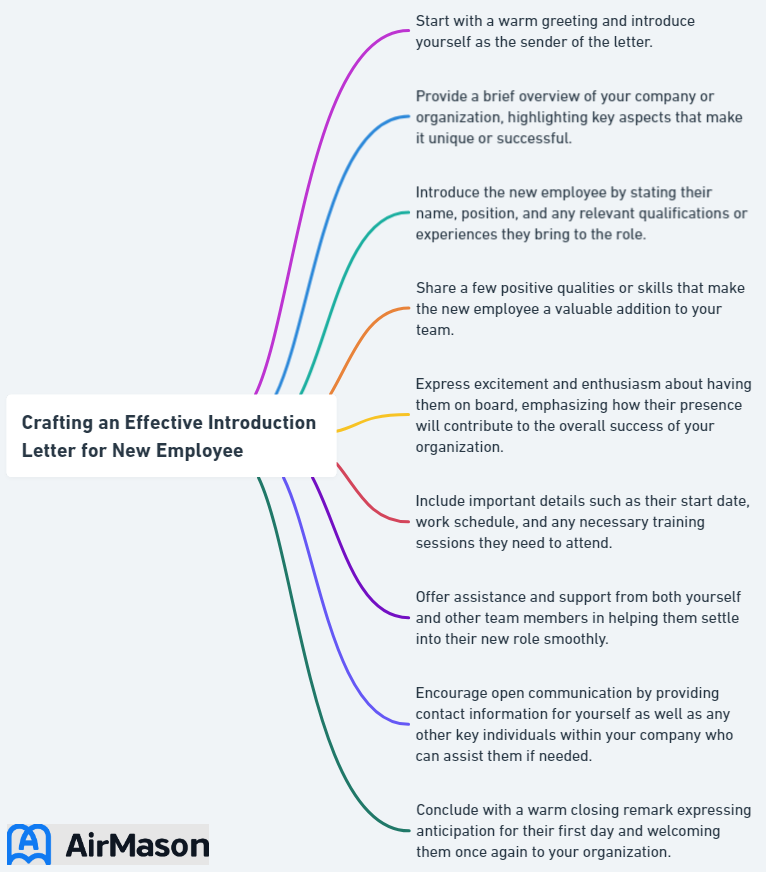
First impressions matter, especially when it comes to welcoming new employees. Crafting an effective introduction letter for new employee sets the stage for a successful onboarding experience and a positive work environment. In this blog post, we will guide you through the essentials of creating a compelling introduction letter, tailored to your company culture, and filled with valuable information to make your new hires feel valued and connected to their new team.
Key Takeaways
- An introduction letter is an important tool used to create a supportive work environment and ensure successful onboarding.
- It should include personalized greetings, information about the new hire’s role and background, as well as interesting personal details.
- Tailor the tone of your introduction letter to the company culture by respecting employees, informing them, promoting accountability & exemplifying positive leadership.
The Purpose of a New Employee Introduction Letter
A new employee introduction email serves as a vital tool in creating a warm welcome for new team members. It not only demonstrates appreciation for their presence but also creates a conducive environment for a successful onboarding process. Sending an introduction email can help mitigate potential surprises and pave the way for the new hire’s success in a supportive work environment.
A well-written employee introduction email should include pertinent information and consider different parameters and alternatives to guarantee effectiveness. For example, email is an effective method to announce a new colleague. Utilizing an employee introduction email template can also be helpful to ensure all necessary information is included and that the new employee feels welcomed by current team members.

Welcome to the Team
We are thrilled to extend our warmest welcome to you as the newest member of our team. Your presence is not just a valuable addition but also a significant milestone in our collective journey towards success. “Welcome in the team” takes on a special meaning for us, signifying the opening of a new chapter filled with collaboration, growth, and achievement. Your unique skills and perspectives are precisely what we were seeking, and we believe that you will play an integral role in our shared pursuit of excellence. We encourage you to bring forth your ideas, ask questions, and immerse yourself in the vibrant tapestry of talents that make up our team. Together, we will undoubtedly achieve great things. Once again, a heartfelt welcome to you!
Key Components of an Introduction Letter
An effective introduction letter should capture the attention of recipients and provide necessary information about the new hire. In this section, we will discuss the essential elements of an introduction letter, such as:
- Personalizing the greeting
- Highlighting the employee’s role and background
- Sharing interesting personal details.
Personalizing the Greeting
Customizing the greeting in the introduction letter is of great significance, as it fosters a sense of belonging and connection for the new employee within the entire company. Some tips for customizing the greeting include:
- Addressing the recipient directly
- Using effective subject lines
- Showing your effort to personalize the message
- Fostering a personal connection
Your introduction letter’s subject line should be clear and concise. In the greeting section of your welcome letter, it should contain:
- A formal salutation
- A sentence outlining the letter’s purpose
- The full name of the person being introduced
- Relevant professional background information
Utilizing an employee introduction email template can be helpful in ensuring all necessary information is included in a captivating and personalized manner, with subject line examples to make a great first impression.
Highlighting the Employee’s Role and Background
Starting with the new employee’s name and role in the organization is a professional way to highlight their experience. Subsequently, present a succinct summary of their pertinent experience and credentials, emphasizing any noteworthy accomplishments or successes. For example, Waylon Singh, a valuable asset and new team member to the company, possesses a Bachelor in Graphic Design and has been engaged in his own projects as a freelancer for a number of years.
Including specific examples or projects that have been successfully completed, and highlighting their individual skills and strengths can provide a clear understanding to the recipients. Furthermore, it may be beneficial to include the rationale behind the new hire as well as their commencement date, adding a personal touch or entertaining details to make the introduction letter more captivating.
Sharing Interesting Personal Details
Incorporating personal details about the new employee, such as hobbies and interests, can facilitate the team to establish a personal rapport with them. Sharing hobbies and interests allows employees to discover common ground and bond over shared activities, fostering stronger relationships and better teamwork.
Abstain from disclosing excessive personal information and concentrate on pertinent details such as the employee’s name, job title, and start date. Include personal particulars that the new employee has provided to you or the recruitment team, ensuring a favorable work atmosphere and a sense of camaraderie within the team. However, it is important to respect privacy and only share the new employee’s contact details when necessary and with their consent.
Welcome a New Employee Letter
Writing a thoughtful and well-crafted welcome a new employee letter is an essential step in setting the tone for a positive work relationship. This letter serves as the first official communication between the company and the new hire, making it an opportunity to convey enthusiasm and eagerness for their arrival. It should not only extend a warm welcome but also provide important details about their first day, such as start time, dress code, and any necessary paperwork. Additionally, expressing confidence in their abilities and emphasizing the value they bring to the team can help instill a sense of belonging and purpose from the very beginning. Including a brief overview of the company’s culture and mission can also help the new employee feel more connected to the organization’s values and goals. Finally, offering assistance and making it clear that questions or concerns are welcome can go a long way in ensuring a smooth onboarding process.
Tailoring the Tone to Your Company Culture

Maintaining the company’s cultural tone in an introduction letter is vital as it shows your understanding and alignment with the organization’s principles, character, and work environment. It facilitates the formation of a favorable impression and illustrates your compatibility within the organization.
To grasp your company’s culture, you should:
- Respect employees
- Keep everyone informed
- Promote accountability
- Listen to employees’ opinions
- Be consistent in your actions and language
- Maintain composure
- Exemplify positive leadership
- Continually reinforce core values
- Foster an environment where everyone feels safe to voice concerns or suggestions
- Appreciate honest feedback
- Clarify expectations for the future.
Introduction Letter Dos and Don’ts

A well-crafted introduction letter should include essential elements such as:
- A header
- Greeting
- Introduction
- Job title
- Key skills
- Values
- Closing paragraph
To ensure professionalism in your new employee welcome letter, employ a formal and professional tone, demonstrate confidence and clarity in your communication, abstain from using casual language, furnish pertinent information regarding the new employee, keep the letter succinct, and create a welcoming atmosphere.
On the other hand, when writing introduction letters, it is important to avoid including:
- Personal or confidential information
- Negative or controversial statements
- Irrelevant or excessive details
- Inappropriate or unprofessional language
- Discriminatory or biased content
Adhering to these dos and don’ts assists in creating a compelling and effective introduction letter that appeals to the recipients and makes the new employee feel appreciated.
Examples of Effective Introduction Letters

An effective employee introduction email should include the new hire’s title, responsibilities, professional and academic accomplishments, as well as a few interesting facts about them. Various organizations modify their introduction letters to reflect their company culture by including the company’s values and mission statement, emphasizing remarkable aspects of the culture, utilizing language and tone that is in-line with the culture, providing information about traditions or events, and emphasizing teamwork and collaboration.
For example, a tech start-up may use a casual and friendly tone to introduce their new software engineer, focusing on their coding expertise, recent successful projects, and interests in gaming and hackathons. On the other hand, a law firm may opt for a more formal tone, introducing their new attorney by highlighting their legal qualifications, experience in high-profile cases, and commitment to client service.
Crafting an introduction letter that aligns with the company culture and job position results in an engaging and effective introduction that appeals to the recipients and helps the new employee feel welcomed and appreciated.
Making the First Day Special: Additional Welcome Ideas

Although an introduction letter plays a vital role in welcoming new employees, exploring other creative ways to make their first day special is equally important. Personalized welcome gifts, such as branded company merchandise or a swag pop-up shop, can heighten brand recognition and create a unique shopping experience for new employees.
Another approach to make the first day memorable is by organizing team-building activities, such as solving puzzles, hosting a brainstorming session, or conducting a show and tell. Additionally, implementing mentorship programs that pair experienced employees with new hires can facilitate the acquisition of knowledge and skills necessary for success in their roles.
Email Introduction to New Team
Sending an email introduction to your new team is a crucial step in establishing a positive and productive working relationship. When crafting this email, it’s essential to strike the right balance between professionalism and approachability. Begin by addressing the email to your team members, using a warm and friendly tone to create a welcoming atmosphere. Start by introducing yourself and providing a brief overview of your background and experience. Highlight your enthusiasm for joining the team and your eagerness to contribute to its success. Additionally, consider including a personal touch, such as mentioning a shared interest or expressing your excitement about collaborating with specific team members. Conclude the email by inviting team members to reach out, fostering open communication and laying the foundation for a successful partnership.
Summary
In conclusion, crafting an effective introduction letter plays a crucial role in setting the stage for a successful onboarding experience and fostering a positive work environment. By personalizing the greeting, highlighting the employee’s role and background, sharing interesting personal details, tailoring the tone to your company culture, and following the dos and don’ts, you can create an engaging and welcoming introduction letter that resonates with your team. Remember, the first impression matters; make it count by going the extra mile and exploring additional welcome ideas to ensure your new hires feel valued and connected from day one.
Frequently Asked Questions
How do you write an introduction letter for a new employee?
Greet the new employee by name and formally welcome them to the team. Provide a brief overview of their qualifications and professional experience, mentioning any notable projects or clients they have worked with. Lastly, confirm the date when the change will take effect. Use a formal tone throughout.
How do you introduce yourself as a new employee?
Hello, I’m (your name), the new (job title) at (company name). I recently moved here with my family and am excited to be joining the team. I’m looking forward to getting to know you better and working together.
What is the best welcome letter for a new employee?
Welcome aboard, [Name]! We are delighted to have you join us and we can’t wait to benefit from your expertise. As we discussed, your first day will be on [date, month], please arrive at 10 AM.
What is the purpose of a new employee introduction letter?
The purpose of a new employee introduction letter is to extend a warm welcome, demonstrate appreciation and create an environment conducive to successful onboarding.
What are the key components of an effective introduction letter?
An effective introduction letter should include a formal greeting personalized to the reader, an overview of the employee’s role and background, and interesting personal details to foster connection.